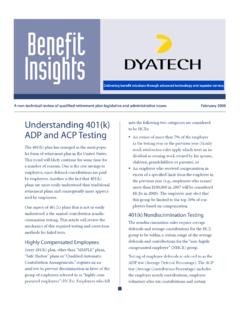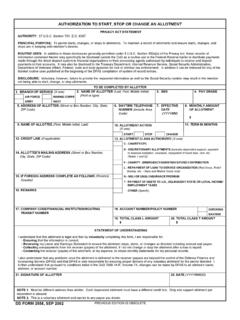Transcription of Benefit Insights - Dyatech
1 Benefit Insights Delivering bene t solutions through advanced technology and superior service. A non-technical review of quali ed retirement plan legislative and administrative issues April 2006. Military leave Rules Coverage Under USERRA. USERRA generally protects all employees (but for Retirement Plans not independent contractors) who serve in any of the following roles: The Uniformed Services Employment and Reemployment Rights Act of 1994 ( USERRA ) Members of the Army, Navy, Air Force, Marine protects the rights of employees who leave their Corps, and Coast Guard;. employment to enter military service. Among its Members of the Reserves, Army and Air Na- protections are a number of rules governing con- tional Guards (when called up under federal, tributions to and the crediting of service under an rather than state, authority);. employer's retirement plan. Members of the National Disaster Medical System; and The Department of Labor ( DOL ) recently is- Members of the Commissioned Corps of the sued nal regulations, effective January 16, 2006, Public Health Service.
2 That clarify USERRA's employee bene t plan To be eligible for USERRA protections, an em- requirements and update the notice of USERRA. ployee must generally give advance notice to his rights that employers are required to provide to employer of the need to be absent for military their employees. service. Notice may be given orally or in writing. This newsletter focuses on the nal USERRA Notice is not required where notice is impossible rules affecting retirement plans. or unreasonable to give under the circumstances. USERRA's Scope After an honorable discharge, an employee must generally apply for reemployment, based on the USERRA's retirement plan protections apply to all following timetable, to receive USERRA-provided employers (regardless of size), including foreign reemployment bene ts: employers doing business in the and many foreign subsidiaries of companies. Service less than 31 days: The rst workday that is at least eight hours after returning home.
3 De ned Contribution Plans Without Service from 31-180 days: Within fourteen Employee Contributions days after completing service. When an employee is rehired by an employer Service in excess of 180 days: Within ninety maintaining a de ned contribution plan that days of completing service. does not require employee contributions, such as If an employee is hospitalized or convalescing a money purchase or pro t sharing plan, the em- from an illness or injury incurred or aggravated ployer is required to make the contributions that during military leave , he must submit an appli- would have been made on the employee's behalf cation for reemployment to the employer at the had he been employed by the employer during end of the period necessary for recovering from the period of military service. the illness or injury. This period may not exceed These contributions must be made by the later of: two years from the date of the completion of service (except in certain circumstances beyond Ninety days after the date of reemployment, or an employee's control that make reporting within When plan contributions are normally due the period impossible or unreasonable).
4 For the year in which the military service was performed. Retirement Plans Covered by USERRA. USERRA applies to retirement plans covered by If, however, it is impossible or unreasonable for the Employee Retirement Income Security Act an employer to make these contributions within of 1974 ( ERISA ) and non-ERISA plans such this time period, the employer must make the as those sponsored by a state, government entity contributions as soon as practicable. An employee (other than the Federal Thrift Savings Plan) or is not entitled to any allocation of forfeitures or church. earnings on missed contributions that he would have received during his period of military ser- Notice Requirements vice. Employers are required to post, mail or email notice to their employees of their USERRA rights, EXAMPLE: Prior to entering military service on Jan- bene ts and obligations. A revised version of the uary 1, 2007, Harry participated in his employer's DOL's model USERRA notice was published in pro t sharing plan which provides for an annual December 2005 and is required to be used on and contribution of 1% of his compensation.
5 When after January 18, 2006. Harry is reemployed on October 1, 2009, his em- ployer must make pro t sharing contributions of Service Crediting After 1% of the compensation he would have received Reemployment during the period he was on military leave . After an employee is reemployed after military service, he must be treated as having not had a Contributions for the 2007 and 2008 plan years break in service under the employer's retire- must be contributed within 90 days of October ment plan. Rehired employees are treated as 1, 2009. Contributions for the 2009 plan year having uninterrupted service with the employer must be made by the due date for regular 2009. during the entire period of absence related to contributions. Harry will not be credited with any military service for purposes of determining par- investment return on these make-up contribu- ticipation, vesting and accrual of bene ts. tions for the period of his military service.
6 Benefit Insights De ned Contribution Plans With pensation. When Susan is reemployed on January Employee Contributions 1, 2009, her employer must allow her to make When an employee is rehired by an employer up the deferrals she could have made during her maintaining a de ned contribution plan that period of military service. She has ve years from permits employee contributions, such as 401(k) her date of reemployment to make up the missed deferrals, the employee must be permitted to contributions. make up, in whole or in part, the contributions When made, these deferrals must be matched that could have been made had he been employed by her employer at 50 for each $ under the by the employer during the period of military ser- plan's matching contribution formula. Make-up vice. Also, the employer is obligated to match an matching contributions must be contributed to employee's make-up contributions if the employ- the plan on the same timetable that applies to ee contributions missed during the employee's regular matching contributions.
7 Susan will not be military service were eligible for employer match- credited with any investment return on these con- ing contributions. tributions for the period of her military service. If an employee wants to make up missed em- De ned Bene t Plans ployee contributions, the employee must make In a non-contributory de ned bene t plan, these contributions within the period that is the upon reemployment bene ts will be the same as lesser of: though the employee had remained continuously Three times the period of military service, or employed during the period of military service. Five years from the date of reemployment. In a contributory plan, the employee will need to make up contributions in order to have the same An employee may only make these contributions bene t as if he had remained employed. while employed with his post-service employer. Calculation of Compensation Once missed employee contributions have been In determining the amount of contributions or made, an employer is required to make up the accrued bene ts, an employer must use the rate matching contributions, if any, using the same of pay that an employee would have received dur- timetable that would normally apply to the con- ing a period of military service.
8 If the rate of pay tribution of employer matching contributions. the employee would have received is not reason- An employee is not entitled to any allocation of ably certain (for example, where an employee's forfeitures or earnings on missed contributions compensation is based on commissions), the that he would have received during his period employee's average rate of compensation in the of military service and may not contribute the twelve-month period prior to entering military amount of earnings he would have received dur- service is used as an employee's compensation. ing this period. Repayment of Prior Distributions EXAMPLE: Prior to entering military service If an employee is a participant in a de ned bene t on January 1, 2007, Susan participated in her plan, he must be permitted to repay any distribu- employer's 401(k) plan that provided that an tions made in connection with the military leave , employee's deferrals would be matched 50 for including interest.
9 Repayment must be made each $ contributed on the rst 6% of com- within the same timeframe as employee make-up Benefit Insights contributions to a de ned contribution plan or Suspension of Plan Loan Payments such longer time as may be agreed to between the employer and the employee. Distributions from Under the Internal Revenue Code, a plan may de ned contribution plans may not be repaid. suspend loan payments for participants in mili- tary service. Upon rehire, loan repayments must Interest Rate on Plan Loans Capped recommence and be repaid in full (including Another military service related law, the Service- interest that accrued during the period of military members Civil Relief Act of 2003 ( SCRA ), caps service) by the end of the period which equals the the interest rate on retirement plan loans. The original term of the loan plus the period of mili- types of military service covered by the SCRA are tary service.
10 The loan can either be reamortized similar, but not identical, to the types of service to take into account interest accrued during the covered by USERRA. suspension, or the participant can make a balloon payment at the end of the extended loan repay- Under the SCRA, the maximum interest rate that ment period. a plan may charge on plan loans outstanding at the start of active duty service is equal to 6% from Conclusion the date on which the employee is called to active USERRA imposes signi cant requirements on service. Any interest in excess of the 6% cap must retirement plan sponsors and administrators. be forgiven, not simply postponed. However, a Plan sponsors who employ individuals who enter court may allow an interest rate higher than 6% or return from military service should carefully if the employee's ability to pay is not materially review their plans to make sure they provide the affected by his or her military service.




